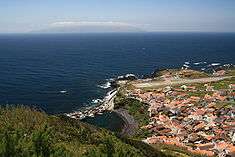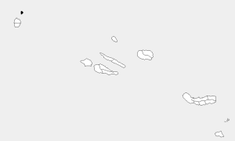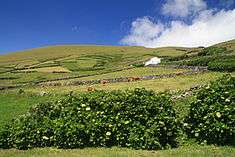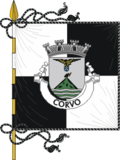Vila do Corvo
| Vila do Corvo | |||
| Municipality (Concelho) | |||
 Vila do Corvo, as seen from Portão lookout, including Aerodrome and settlement | |||
|
|||
| Official name: Concelho da Vila do Corvo | |||
| Name origin: corvo, Portuguese for crow | |||
| Country | |||
|---|---|---|---|
| Autonomous Region | |||
| Island | Corvo | ||
| Localities | Vila do Corvo, Enseada de NªSª do Rosário, Calçada | ||
| Landmark | Nossa Senhora dos Milagres | ||
| Center | Vila do Corvo | ||
| - elevation | 36 m (118 ft) | ||
| - coordinates | 39°40′22″N 31°6′52″W / 39.67278°N 31.11444°WCoordinates: 39°40′22″N 31°6′52″W / 39.67278°N 31.11444°W | ||
| Highest point | |||
| - location | Estreitinho, Caldeirão | ||
| - elevation | 718 m (2,356 ft) | ||
| - coordinates | 39°41′55″N 31°6′40″W / 39.69861°N 31.11111°W | ||
| Lowest point | Sea level | ||
| - location | Atlantic Ocean | ||
| - elevation | 0 m (0 ft) | ||
| Area | 17.11 km2 (7 sq mi) | ||
| - water | .31 km2 (0 sq mi) | ||
| - urban | .11 km2 (0 sq mi) | ||
| Population | 430 (2011) | ||
| Density | 25/km2 (65/sq mi) | ||
| Settlement | c.1475-1503 | ||
| - Parish | c.1674 | ||
| - Town/Municipality | 20 June 1832 | ||
| LAU | Câmara Municipal | ||
| - location | Rua do Jogo da Bola | ||
| - elevation | 34 m (112 ft) | ||
| - coordinates | 39°40′22″N 31°6′48″W / 39.67278°N 31.11333°W | ||
| President | Manuel das Pedras Rita (PS) | ||
| Municipal Chair | Oscar Manuel Rocha (PS) | ||
| Timezone | Azores (UTC-1) | ||
| - summer (DST) | Azores (UTC0) | ||
| Postal Zone | 9980-024 | ||
| Area Code & Prefix | (+351) 292 XX XX XX | ||
| Demonym | Corvense | ||
| Patron Saint | Nossa Senhora dos Milagres | ||
| Municipal Holidays | 20 June | ||
| Status | Architectural Group of Public Interest | ||
| Listing | Regional Government of the Azores, Resolution n.º 69/97; JORAA n.º 15, 10 April 1997; included in the Rede Natura 2000 ZEP (Zona de Protecção Especial) | ||
 Location of the municipality of Corvo in the archipelago of the Azores
| |||
| Wikimedia Commons: Corvo | |||
| Website: http://www.cm-corvo.pt | |||
| Statistics from INE (2001); geographic detail from Instituto Geográfico Português (2010) | |||
Vila do Corvo (Portuguese pronunciation: [ˈkoɾvu]) is the smallest municipality in the Portuguese archipelago of the Azores, constituting the island of Corvo in its entirety. With a population of 430 in 2011,[1] it is the least populated of the Portuguese municipalities, and the only Portuguese municipality, by law, without a civil parish (freguesia, the smallest administrative unit in Portugal). Its area is 17.11 km².[2]
Vila do Corvo, has at times been wrongly referred to as Vila Nova do Corvo. The village, the unique agglomeration on the island of Corvo, is constructed of small homes located along narrow roadways and alleys rising along the hills of the southern one-third of the island. The coastal area of the village is dominated by the Corvo Aerodrome and ports linking the community to the outside world.
History

The history of the Azores is linked to non-official exploration during the period of the late 13th century in maps, such as the Genoese Atlas Medici (1351). Although it did not specify an island of Corvo, the Medici Atlas did refer to an Insula Corvi Marini (Island of the Marine Crow), in a seven-island archipelago. A later Mapa Catalão (Catalan Map), from Spain, referred to two islands of Corvo and Flores in 1375.
During Portuguese official history the Western Group was discovered during the navigator Diogo de Teive and his son's (João de Teive) 1452 return from the Banks of Newfoundland, after his second voyage of exploration.[3][4] The Portuguese Court began to refer to the new Ilhas das Flores (Islands of Flowers), identifying Corvo as the Ilha de Santa Iria (Island of Saint Irene), but other nautical charts continued to refer to this island as the Ilhéu das Flores (Islet or Island of Flowers), Ilha da Estátua (Island of the Statute), Ilha do Farol (Island of the Lighthouse) or Ilha de São Tomás (Island of Saint Thomas).[5] The island was placed under the control of Diogo Teive, who became the first Captain-Donatário.[4]
Regardless, it was only in the following year that King Afonso V of Portugal "recognized" these new discoveries (20 January 1453) and donated them to his uncle, Afonso, Duke of Braganza and Count of Barcelos.[3][4] The first proprietor showed little interest in settlement, sending only the obligatory cattle to settle the island and establish his legtimate possession.
Fernão Telles, the third Captain-Donatário between 1475 and 1503, was the first to attempt to colonize Corvo (contracting the Flemish entrepreneur Willem van der Haegen), but abandoned his settlement after a couple of years.[3][4] By 1507, both islands of Corvo and Flores were identified by Valentim Fernandes as unpopulated.[3] Diogo das Chagas also referred to an initial settlement of 30 people, under contract of Terceirenses Antão Vaz and Lopo Vaz de Azevedo (1508–1510), who had little success on Corvo; they eventually returned to Terceira in 1515, leaving António Silveira de Machado in charge. But the settlement did not persist.[3][6] Following these successive failed attempts to settle the land, Gonçalo de Sousa (second Captain-Donatário of the islands of Corvo and Flores) was authorized to send slaves (likely from the island of Santo Antão, in the Cape Verde archipelago) to Flores and Corvo as farmers and cattlemen (12 November 1548).[3]
In 1570, the building that would later become the Church of Nossa Senhora dos Milagres was constructed.[4]
Around 1580, colonists from Flores arrived on Corvo, and a small self-sufficient, isolated settlement was formed. These Corvinos survived a meagre existence, dedicating their venture to subsistence crops and grazing sheep and/or goats, along with fishing offshore. Commerce and trade primarily occurred across the channel, but atmospheric conditions restricted maritime connections to the rest of the islands between March and September. As Gaspar Frutuoso later indicated, by the end of the 16th century the population consisted of houses "...of 20 neighbours, renters and masters' blacks...certain slaves, and married mulattos with slaves..."[3]
Along with Flores, the island passed into the hands of Martinho de Mascarenhas in 1593. But the situation economically became aggravated and desperate: the annual payments to the seigneur increased;[7] the local population increased; the connection with the outside world reluctantly forced a level of self-sufficiency; the impossibility of increasing the area under cultivation; and the frequent incursions by English privateers, that marked the conflict during the Iberian Union.[3]
Much like other Azorean communities in the late 16th century, piracy and privateering marked their local history, even as some locals collaborated with or befriended these raiders. In exchange for protection and payments, the islanders provided fresh water, provisions and men, as well as permitting the treatment of the sick and repairing vessels. But in 1587 Corvo was sacked by English privateers who had attacked Lajes das Flores. Then, in 1632, Barbary coast pirates (from the Ottoman Empire) twice attempted to disembark in Porto da Casa, which was only a small bay (and an area that was easily accessible to pirates). In one account, while the men were in the hills looking after their flocks and the women were in their homes, a large group of pirates arrived in the vicinity of the settlement. The pirates fired on the settlement, and were met by rocks thrown from the cliff-tops. During the battle, the local vicar carried his small image of Nossa Senhora do Rosário (Our Lady of the Rosary) into the battle, and placed it along the Canada da Rocha. The statue had for many years been placed in the area of Porto da Casa, but had been moved to the altar of the small chapel on the cliff. The battle was arduous, but 200 Corvinos were able to defeat the pirates, capturing many weapons, with no loss of life and while capturing a Moor. It is said that the victory was credited to the statue, which was the patron saint of Corvo, and had mysteriously deflected many of the pirates' rounds. The pirates retreated and did not return to the small island. Thereafter the statue became known as the statue of Nossa Senhora dos Milagres (Our Lady of Miracles). It was the second parish priest, the Florentine Inácio Coelho (brother of the Diogo das Chagas), who was able to convince Martinho de Mascarenhas (the second Captain-Donatário) to assist the parish "in the name of the Virgin Mary". Today the statue is located in the parochial church.
The parish of Corvo was created in 1674: its first pastor was the Faialense Bartolomeu Tristão. Until this time the colony was annually visited by a priest from Santa Cruz das Flores, sent by the Bishop of Angra to tend to the isolated community.
In the 18th century, American whalers arrived in Flores to recruit crews and harpooners, and to re-provision their ships for their campaigns. Due to their experience, inhabitants from Corvo signed onto these crews, thus beginning a close relationship with the New England community of North America that would continue into the 20th Century (at times, this connection was more direct than its connection to Lisbon). Consequently, clandestine emigration was a constant of life, and a problem for the repressive Portuguese authorities, who were preoccupied with defections from obligatory military service and reductions in island tribute. The settlers on Corvo were obliged to pay a tithe to their Captains-Donatário, and after 1759 (with the death of the 8th Duke of Aveiro and Count of Santa Cruz), to the Crown.[4] During the Liberal Wars, a delegation from Corvo approached Regent Peter IV of Portugal to present the grave sentiments of the population and request that their payments be alleviated. Manuel Tomás de Avelar, chief of the Corvino delegation, traveled to Angra do Heroísmo to petition the liberal leadership of the Angra Regency. It was Mouzinho da Silveira who attempted to mitigate this servitude with a proposal to reduce the tithe payment (in wheat) and taxes, owing to the persistent poverty on the island. A decree was promulgated on 14 May 1832 by Peter IV and signed in Ponta Delgada, that reduced the tithe paid to the Crown's Donatário (then Pedro José Caupers) in half (to 20 moios [470 US bushels (17 m3)][8] of wheat), as well as the elimination of the annual payment of 80,000 réis. The Crown would then assume the indemnity of the Donatário. The tribute was completely abolished by 1835.
On 20 June 1832, the Regent, Peter IV of Portugal, elevated the settlement of Corvo to the status of village and municipal seat.[4] Until this time Corvo had been under the jurisdiction of Santa Cruz das Flores, as a civil parish of its neighbor across the channel. And after 1853, the foral (the town's royal charter) granted to the dual jurisdiction was extinguished, resulting in a liberal movement, where tenant farmers were able to raise their cattle and till their own lands, marking out a subsistence economy that supported porting ships.[4]
In 1886 the Civil Governor of the District of Horta, Manuel Francisco de Medeiros, asked the inhabitants what they wanted on visiting the community. He was surprised by the humble request of a Portuguese national flag for the island. It came into use when Albert of Monaco visited the island during his oceanographic and photographicexpeditions. It was also visited in 1924 by the Portuguese writer Raul Brandão, who contributed to local myths and idyllic republican community with his work Ilhas Desconhecidas.
From the beginning of the 19th and into the 20th century immigration continued unabated, except for a period between 1925 and 1955, as more Corvinos left the island in search of economic security— a process that continued well into the 1980s. By 1938, the island received its first permanent medical resident, João Rodrigues Ferreira da Silva, who lived on the island until 1945, and for whom the only medical building was named.
On 10 April 1997, the urban nucleus of the village of Corvo consisted primarily of the old one and two-storey house/barns that populated the centre of the municipality and were classified as an architectural group of public interest' (Portuguese: Conjunto de Interesse Público) by the Regional Government of the Azores, supported by IGESPAR.[4]
Geography
|
|
The Vila do Corvo is implanted along the maritime coast of the island Corvo, and represents the only inhabited settlement on the island.;[4] With a perimeter of 17 kilometres (11 mi), the settlement is dominated by the sheer cliffs of the extinct volcanic crater of the Caldeirão, which extend 718 metres (2,356 ft) above sea level.[4] The urban area covers 6.5 metres (21 ft) by 3 metres (9.8 ft) on an ancient debris field in the south, along the cove of Nossa Senhora do Rosário.[4] The landscape north of the settlement is characterized by agricultural fields and pastureland, divided by stone walls.[4]
In the last part of the 19th century, a 9% drop in the population marked a period of emigration to the United States, generally associated with most of the archipelago. Yet continued emigration between Corvo and New England would mark the demographic oscillation during the 20th century, as well. There were four identifiable periods:[3]
- the first period, until 1925, when the United States began restricting immigration and the local population diminished by 18%
- the second period, until 1955, during a period of emigration to Latin America, (principally to Brazil) that was fairly insignificant, but resulted in a 10% increase in the population
- a third period, which lasted until the beginning of the 1980s, coincident with a new wave of emigration, resulting in a 49% decrease in the local residents
- finally, from the 1980s until the beginning of the 21st century, resulting from new restrictions on emigration, and local social and economic development, that resulted in little change
In the last 14 years that population has seen a 12.5% increase, which is attributed to the following factors:[3]
- the return of émigrés
- the appearance of new employment opportunities, in addition to the creation of a basic education primary school, which helped to fix the young population
Climate
Vila do Corvo has a borderline Mediterranean (Csa) and humid subtropical climate (Cfa).
| Climate data for Corvo | |||||||||||||
|---|---|---|---|---|---|---|---|---|---|---|---|---|---|
| Month | Jan | Feb | Mar | Apr | May | Jun | Jul | Aug | Sep | Oct | Nov | Dec | Year |
| Average high °C (°F) | 17 (62) |
16 (60) |
16 (61) |
17 (63) |
18 (65) |
22 (71) |
24 (76) |
26 (78) |
24 (75) |
21 (70) |
19 (66) |
17 (63) |
20 (68) |
| Average low °C (°F) | 14 (57) |
12 (54) |
13 (55) |
13 (56) |
15 (59) |
17 (63) |
19 (67) |
21 (70) |
20 (68) |
18 (64) |
16 (60) |
14 (58) |
16 (61) |
| Average precipitation mm (inches) | 150 (5.9) |
130 (5) |
117 (4.6) |
69 (2.7) |
61 (2.4) |
43 (1.7) |
30 (1.2) |
58 (2.3) |
99 (3.9) |
81 (3.2) |
89 (3.5) |
84 (3.3) |
1,011 (39.8) |
| Source: Weatherbase [9] | |||||||||||||
Economy
Generally, the inhabitants dedicate themselves to fishing, agriculture, or raising cattle. Most services on the island support these activities, as well as annual tourism.
Although the island is small, the municipal government constructed a small campsite in the area of Praia da Areia, with washrooms, barbecues and picnic tables in order to support annual eco-friendly visitors to the island.[10]
Architecture
The centre of Vila do Corvo, situated in the eastern part of the Rua da Matriz and characterized by a group of narrow roads, alleyways and a labyrinth of buildings, is the historic town.[11] The buildings are generally two-storey constructions, oriented towards the south and roofed in tile. Some of these buildings continue to have spaces for pig-pens, corrals and annexes aligned to the alleyways.[11]
Civic
- Correios, Telégrafos e Telefones (CTT) Building (Portuguese: Edifício dos Correios, Telégrafos e Telefones, CTT, do Corvo), common on many of the islands of the Azores, the CTT building is a 20th-century construction located in the Largo do Ribeirão[12]
- Pit of Junça (Portuguese: Cova de Junça), a subterranean silo in the form of an amphora, used to store cereals, constructed in the 18th century
- Lighthouse of Ponta Negra (Portuguese: Farol de Ponta Negra), located west of the small port of Boqueirão, alongside the windmills of Corvo, it was established in 1910 to secure the southern coast of the island[13]
- Public Office Building (Portuguese: Edifício das Repartições Públicas do Corvo), the building of the antique public finances for the island of Corvo, built during the 20th century[14]
- Residence of Mariana Lopes (Portuguese: Casa de Mariana Lopes)
- Threshing Circle (Avenida Nova) (Portuguese: Eira de Avenida Nova)
- Windmills of Corvo (Portuguese: Moinhos de Vento) - a group of three windmills located along the Caminhos dos Moinhos (Windmill Ways), constructed of volcanic rock in a conical form, with a wooden roof and octagonal sails, accessed by elevated doorways with volcanic lateral symmetrical steps[15][16]
Religious
- Church of Nossa Senhora dos Milagres (Portuguese: Igreja Paroquial de Vila Nova do Corvo/Igreja de Nossa Senhora dos Milagres), the 18th century Baroque-remodelled parochial church was constructed in 1570, to house the legendary image of Our Lady of the Miracles who "miraculously" saved the Corvinos from pirate attacks during the 16th century[17]
- Império of the Divino Espirito Santo (Portuguese: Casa do Divino Espírito Santo), a simple rectangular building used for celebrations tied with the Cult of the Holy Spirit, constructed around 1871[18]
Culture
The island celebrates annual celebrations marking the feast day of their patron, Our Lady of Miracles (Portuguese: Nossa Senhora dos Milagres), on 15 August.[19] The event is actually a week-long religious celebration of prayer, with an evening candle-light procession on the evening of 14 August, before the events on 15 August, which include a solemn mass.[19] Connected with this celebration is the annual Festival dos Moinhos (literally, Festival of the Windmills), a secular musical event that attracts tourists and ex-emigrants to the tiny island, featuring local and popular musical talent.
References
- Notes
- ↑ Instituto Nacional de Estatística
- ↑ Eurostat Archived September 6, 2014, at the Wayback Machine.
- 1 2 3 4 5 6 7 8 9 10 José Saramango (2006)
- 1 2 3 4 5 6 7 8 9 10 11 12 13 Costa, Anouk (2011), SIPA, ed., Núcleo urbano da vila do Corvo/Núcleo antigo da vila do Corvo (PT072001010003) (in Portuguese), Lisbon, Portugal: SIPA – Sistema de Informação para o Património Arquitectónico, retrieved 26 April 2012
- ↑ For a while it was also known as Ilha do Marco (Island of the Mark), which was attributed to its reference as a geographic marker for sailors, or likely, the location of a small promontory, where a marker was placed, that received the name Ponta do Marco.
- ↑ A similar colony by three Barcelos family members failed following this attempt.
- ↑ The annual stipend (Portuguese: foro) required the Corvinos to pay to the seigneur 40 moios (940 US bushels (33 m3)[8]) of wheat and 80,000 réis in woollen fabrics. Since the sheep and goats were the master's possessions, the wool was sold annually to the population.
- 1 2 "Moio Conversion Chart". Historical Units of Volume Conversion. convert-me.com. Retrieved 2 December 2016.
- ↑ "Weatherbase: Historical Weather for Corvo, Portugal". Weatherbase. 2011. Retrieved on November 24, 2011.
- ↑ "Turismo: Parque de Campismo", Do Corvo Para o Mundo!!! (in Portuguese), 16 June 2011, retrieved 30 August 2011
- 1 2 "Vila Nova do Corvo" (in Portuguese). Angra do Heroísmo (Azores), Portugal: Direcção Regional da Cultura/Secretaria Regional de Cultura. 6 March 2006. Retrieved 14 March 2011.
- ↑ Noé, Paula; Gavinha, José A. (2012). SIPA, ed. "Edifício dos Correios, Telégrafos e Telefones, CTT, do Corvo (PT072001010004)" (in Portuguese). Lisbon, Portugal: SIPA – Sistema de Informação para o Património Arquitectónico. Retrieved 10 November 2012.
- ↑ Costa, Patrícia; Gavinha, José A.; Ferreira, Teresa (2012). SIPA, ed. "Farol da Ponta Negra (PT072001010001)" (in Portuguese). Lisbon, Portugal: SIPA – Sistema de Informação para o Património Arquitectónico. Retrieved 10 November 2012.
- ↑ Costa, Patrícia; Gavinha, José A. (2012). SIPA, ed. "Edifício das Repartições Públicas do Corvo (PT072001010002)" (in Portuguese). Lisbon, Portugal: SIPA – Sistema de Informação para o Património Arquitectónico. Retrieved 10 November 2012.
- ↑ "91.10.1 MOINHOS DE VENTO - AO CAMINHO DOS MOINHOS" (in Portuguese). Angra do Heroísmo (Azores), Portugal: Direcção Regional da Cultura/Secretaria Regional de Cultura. 6 March 2006. Retrieved 14 March 2011.
- ↑ Costa, Patrícia; Gavinha, José A. (2012). SIPA, ed. "Moinhos de Vento do Corgo (PT072001010007)" (in Portuguese). Lisbon, Portugal: SIPA – Sistema de Informação para o Património Arquitectónico. Retrieved 10 November 2012.
- ↑ Noé, Paula; Gavinha, José A. (2012). SIPA, ed. "Igreja Paroquial de Vila Nova do Corvo/Igreja de Nossa Senhora dos Milagres (PT072001010005)" (in Portuguese). Lisbon, Portugal: SIPA – Sistema de Informação para o Património Arquitectónico. Retrieved 10 November 2012.
- ↑ Gavinha, José A.; Noé, Paula (2012). SIPA, ed. "Casa do Divino Espírito Santo (PT072001010006)" (in Portuguese). Lisbon, Portugal: SIPA – Sistema de Informação para o Património Arquitectónico. Retrieved 10 November 2012.
- 1 2 Festa de Nossa Senhora dos Milagres-15 de Agosto (in Portuguese), Vila do Corvo (Azores), Portugal, 8 August 2011, retrieved 5 September 2011
- Sources
- Carvalho, M. (2006). Lenda de Nossa Senhoro Rosário e os Piratas (in Portuguese). 1. Montreal, Canada: O Açoreano.
- Saramango, José (27 March 2006). "Breve Notícia Histórica Sobre a Ilha do Corvo" [A Brief Historical Notice on the Island of Corvo] (in Portuguese). Angra do Heroísmo (Azores), Portugal: Institute Nacional de Cultura/Direcção Regional de Cultura. Retrieved 14 March 2011.
- Fernandes, José Manuel (2008), História ilustrada da arquitectura dos Açores (in Portuguese), Angra do Heroísmo (Azores), Portugal: Instituto Açoriano de Cultura
- Frutuoso, Gaspar (1977–1987), Saudades da Terra (in Portuguese), (republished) Instituto Cultural de Ponta Delgada
- SRAM (March 2010), Estudo de identificação e caracterização das paisagens dos Açores (in Portuguese), III (unpublished), Secretaria Regional do Ambiente e do Mar

